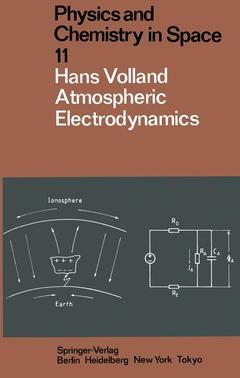Description
Atmospheric Electrodynamics, Softcover reprint of the original 1st ed. 1984
Physics and Chemistry in Space Series, Vol. 11
Author: Volland H.
Language: English
Keywords
Approximative price 84.35 €
Subject to availability at the publisher.
Add to cart
Atmospheric Electrodynamics
Publication date: 09-1984
Publication date: 09-1984
Atmospheric Electrodynamics
Publication date: 02-2012
208 p. · 15.2x22.9 cm · Paperback
Publication date: 02-2012
208 p. · 15.2x22.9 cm · Paperback
Description
/li>Contents
/li>Comment
/li>
This book resulted from lectures which I gave at the Universities of Kyoto, Cologne, and Bonn. Its objective is to summarize in a unifying way two other wise rather separately treated subjects of atmospheric electrodynamics: elec tric fields of atmospheric origin, in particular thunderstorm phenomena and related problems on the one hand, and magnetic fields, in particular those which are associated with electric currents of upper atmospheric origin, on the other. Geoelectricity and geomagnetism were not always considered as be longing to quite different fields of geophysics. On the contrary, they were re cognized by the physicists of the 19th and the beginning of the 20th century as two manifestations of one and the same physical phenomenon, which we pre sently refer to as electromagnetic fields. This can still be visualized from the choice of names of scientific journals. For instance, there still exists the Japanese Journal of Geomagnetism and Geoelectricity, and the former name of the present American Journal of Geophysical Research was Terrestrial Magnetism and Atmospheric Electricity. Whereas geomagnetism became the root of modern magnetospheric phys ics culminating in the space age exploration of the earth's environment, geo electricity evolved as a step-child of meteorology. The reason for this is clear. The atmospheric electric field observed on the ground reflects merely the local weather with all its frustrating unpredictability. The variable part of the geomagnetic field, however, is a useful indicator of ionospheric and magneto spheric electric current systems.
1 Introduction.- 2 Plasma Component of the Air.- 2.1 Sources of Ionization.- 2.2 Ion Composition.- 2.3 Electric Conductivity of Lower and Middle Atmosphere.- 2.4 Electric Conductivity of Upper Atmosphere.- I Thunderstorms and Related Phenomena.- 3 Global Electric Circuit.- 3.1 Electric Fields and Currents.- 3.2 Space Charges.- 3.3 Equivalent Global Electric Circuit.- 4 Thunderstorms.- 4.1 Occurrence of Thunderclouds.- 4.2 Development of a Thunderstorm Cell.- 4.3 Rain Drop Spectra.- 4.4 Electric Fields and Charges in Thunderclouds.- 5. Thunderstorm Electrification.- 5.1 Charge Separation in Clouds.- 5.2 Theory of Precipitation-Powered Electrification.- 5.3 Thunderstorm as Local Generator.- 5.4 Equivalent Current of Local Generator.- 5.5 Thunderstorm as Global Generator.- 6 Lightning.- 6.1 Phenomenology of Lightning.- 6.2 Bruce-Golde and Transmission Line Models of Return Stroke Currents.- 6.3 Resonant Wave Guide Model of Return Strokes and K Strokes.- 6.4 Excitation of Resonant Modes.- 7 Sferics.- 7.1 Observed Wave Forms.- 7.2 Electromagnetic Radiation from Lightning Channels.- 7.3 Propagation Effects on Sferic Wave Forms.- 7.4 Schumann Resonances.- 7.5 Nuclear Electromagnetic Pulses.- II Tidal Wind Interaction with Ionospheric Plasma.- 8 Electric Sq and L Currents.- 8.1 Origin of Sq and L.- 8.2 Observations of Sq Variations on the Ground.- 8.3 Morphology of L.- 8.4 Space Observations Related to Sq.- 8.5 Solar Influences on Sq.- 9 Ionospheric Dynamo.- 9.1 Elements of Tidal Theory.- 9.2 Coupling Between Tidal Wind and Ionospheric Plasma.- 9.3 Diurnal(1, ?2) Mode.- 9.4 Semidiurnal (2, 2) Mode.- 9.5 Equivalent Electric Circuit of Sq.- 9.6 Equatorial Electrojet.- 9.7 Upward and Downward Mapping of Electric Sq Field.- III Solar Wind Interaction with Magnetosphere.- 10 Coupling Between Solar Wind and Geomagnetic Field.- 10.1 Solar Wind and Interplanetary Magnetic Field.- 10.2 Closed Magnetosphere.- 10.3 Open Magnetosphere.- 10.4 Geomagnetic Activity.- 10.5 Seasonal and Universal Time Variations of Geomagnetic Activity.- 11 Global Magnetospheric Electric Fields and Currents.- 11.1 Convection Field.- 11.2 Co-Rotation Field.- 11.3 Polar Cap Field.- 11.4 Electric Hall Current Systems.- 11.5 Polar Electrojets.- 11.6 Ring Current.- 11.7 Magnetospheric Substorm.- 12 Theory of Wave Propagation Within the Magnetosphere.- 12.1 Ray Theory.- 12.2 Full Wave Theory.- 12.3 Excitation of Plasma Waves.- 12.4 Ionospheric Screening Layer.- 12.5 Transmission Line Model of Magnetosphere.- 13 Waves in the Magnetosphere.- 13.1 Geomagnetic Pulsations.- 13.2 Whistlers.- 13.3 Electromagnetic Waves of Magnetospheric Origin.- 13.4 Man-Made Wave Activity.- 14 Appendix.- 14.1 Units and Coordinate Systems.- 14.2 Geomagnetic Dipole.- 14.3 Basic Formulas of Electromagnetism and Hydromagnetics.- 14.4 List of Frequently Used Symbols.- References.
Includes supplementary material: sn.pub/extras
© 2024 LAVOISIER S.A.S.




